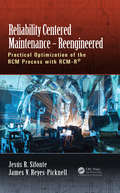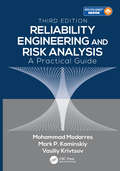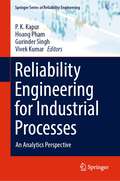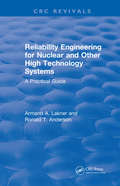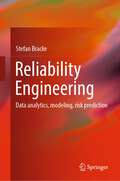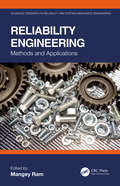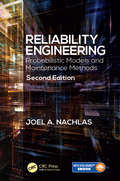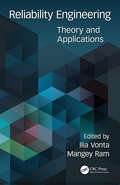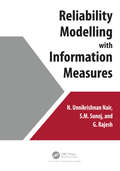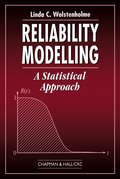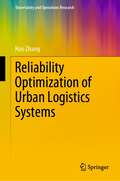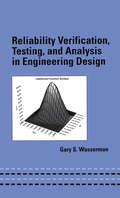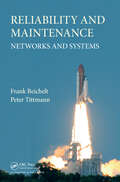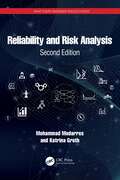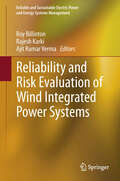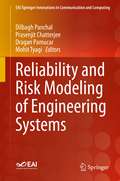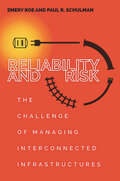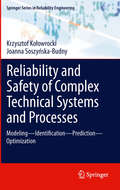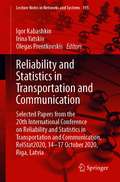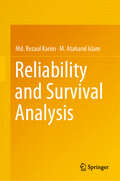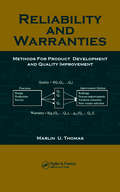- Table View
- List View
Reliability Assessment of Tethered High-altitude Unmanned Telecommunication Platforms: k-out-of-n Reliability Models and Applications (Infosys Science Foundation Series)
by Vladimir Rykov Dmitry V. Kozyrev Dharmaraja Selvamuthu Vladimir M. Vishnevsky Nika Ivanova Achyutha KrishnamoorthyThis book provides a systematic presentation of the major results in the field of the theory of k-out-of-n systems obtained in recent years and their applications for the reliability assessment of high-altitude unmanned platforms. Mathematical models, methods, and algorithms, presented in the book, will make a significant contribution to the development of reliability theory and the theoretical foundations of unmanned UAV-based aerial communications networks in the framework of the concept of creating the 5G and beyond networks. The book gives a description of new mathematical methods and approaches (based on decomposable semi-regenerative processes, simulation and machine learning methods, and inventory models) to the study of the complex k-out-of-n systems, which makes it possible to carry out numerical calculations of reliability indicators. Organized into five chapters, each chapter begins with a summary of the main definitions andresults contained in the chapter. The content of this book is based on the original results developed by the authors, many of which appear for the first time in book form.
Reliability Assessments: Concepts, Models, and Case Studies (International Series In Engineering And Computer Science #Vol. 206)
by Franklin Richard Nash, Ph.D.This book provides engineers and scientists with a single source introduction to the concepts, models, and case studies for making credible reliability assessments. It satisfies the need for thorough discussions of several fundamental subjects. Section I contains a comprehensive overview of assessing and assuring reliability that is followed by discussions of:• Concept of randomness and its relationship to chaos• Uses and limitations of the binomial and Poisson distributions• Relationship of the chi-square method and Poisson curves• Derivations and applications of the exponential, Weibull, and lognormal models• Examination of the human mortality bathtub curve as a template for components Section II introduces the case study modeling of failure data and is followed by analyses of:• 5 sets of ideal Weibull, lognormal, and normal failure data• 83 sets of actual (real) failure data The intent of the modeling was to find the best descriptions of the failures using statistical life models, principally the Weibull, lognormal, and normal models, for characterizing the failure probability distributions of the times-, cycles-, and miles-to-failure during laboratory or field testing. The statistical model providing the preferred characterization was determined empirically by choosing the two-parameter model that gave the best straight-line fit in the failure probability plots using a combination of visual inspection and three statistical goodness-of-fit (GoF) tests. This book offers practical insight in dealing with single item reliability and illustrates the use of reliability methods to solve industry problems.
Reliability Centered Maintenance – Reengineered: Practical Optimization of the RCM Process with RCM-R®
by Jesus R. Sifonte James V. Reyes-PicknellReliability Centered Maintenance – Reengineered: Practical Optimization of the RCM Process with RCM-R® provides an optimized approach to a well-established and highly successful method used for determining failure management policies for physical assets. It makes the original method that was developed to enhance flight safety far more useful in a broad range of industries where asset criticality ranges from high to low. RCM-R® is focused on the science of failures and what must be done to enable long-term sustainably reliable operations. If used correctly, RCM-R® is the first step in delivering fewer breakdowns, more productive capacity, lower costs, safer operations and improved environmental performance. Maintenance has a huge impact on most businesses whether its presence is felt or not. RCM-R® ensures that the right work is done to guarantee there are as few nasty surprises as possible that can harm the business in any way. RCM-R® was developed to leverage on RCM’s original success at delivering that effectiveness while addressing the concerns of the industrial market. RCM-R® addresses the RCM method and shortfalls in its application -- It modifies the method to consider asset and even failure mode criticality so that rigor is applied only where it is truly needed. It removes (within reason) the sources of concern about RCM being overly rigorous and too labor intensive without compromising on its ability to deliver a tailored failure management program for physical assets sensitive to their operational context and application. RCM-R® also provides its practitioners with standard based guidance for determining meaningful failure modes and causes facilitating their analysis for optimum outcome. Includes extensive review of the well proven RCM method and what is needed to make it successful in the industrial environment Links important elements of the RCM method with relevant International Standards for risk management and failure management Enhances RCM with increased emphasis on statistical analysis, bringing it squarely into the realm of Evidence Based Asset Management Includes extensive, experience based advice on implementing and sustaining RCM based failure management programs
Reliability Culture: How Leaders Build Organizations that Create Reliable Products (Quality and Reliability Engineering Series)
by Adam P. BahretBy outlining how reliability engineering practices fit within a product development program, the reader will have a better understanding of how roles and goals align with the program and how this applies to their specific role.Reliability Culture: How Leaders Build Organizations that Create Reliable Products, will help readers develop a deep understanding of reliability, including what it really means for organizations, how to implement it in daily operations, and, most importantly, how to build a culture that is centered around reliability and can generate impressive profits. When senior leaders work toward reliability, product details often get lost in translation. This book will enable organizations to overcome this problem by showing leaders how their actions truly affect product development. They will be introduced to new methods that will immediately enable them to have carefully crafted product specifications translated into matching, highly reliable products. This book will also be a breath of fresh air for reliability engineers and managers; they will see their daily struggle identified and will learn new methods for advancing their passionate struggle. These new methods will be clearly explained, so readers can begin the important process of incorporating and promoting reliability in their organizations. Benefits of this book include: For the organizational leader, this book provides tools for aligning reliability objectives and methods with the company's business and brand goals For the reliability engineer, this book identifies and proposes solutions for integrating their discipline within the larger program objective and activities Engineers and leaders alike will benefit from detailed discussions of product negotiation, program assessment, culture change methods, and more All readers will understand the progression of product design methods over the previous decades, including how market acceptance is changing Reliability Culture: How Leaders Build Organizations that Create Reliable Products is intended for a broad audience that includes organizational leaders, engineers of all disciplines, project managers, and business development partners. The book is aimed at outlining how reliability engineering practices fit with all program activities, so any team members will benefit.
Reliability Engineering and Risk Analysis: A Practical Guide, Third Edition
by Mohammad Modarres Mark P. Kaminskiy Vasiliy KrivtsovThis undergraduate and graduate textbook provides a practical and comprehensive overview of reliability and risk analysis techniques. Written for engineering students and practicing engineers, the book is multi-disciplinary in scope. The new edition has new topics in classical confidence interval estimation; Bayesian uncertainty analysis; models for physics-of-failure approach to life estimation; extended discussions on the generalized renewal process and optimal maintenance; and further modifications, updates, and discussions. The book includes examples to clarify technical subjects and many end of chapter exercises. PowerPoint slides and a Solutions Manual are also available.
Reliability Engineering for Industrial Processes: An Analytics Perspective (Springer Series in Reliability Engineering)
by Hoang Pham P. K. Kapur Vivek Kumar Gurinder SinghThis book explores how transformative changes driven by the new-age economy can bring about improvements in a company's engineering and manufacturing capabilities. The new-age economy is driven by advanced engineering and manufacturing practices, processes, and technologies, including the Internet of Things (IoT), Cloud Computing, Blockchain, Artificial Intelligence, Robotics, Cyber-Physical Systems (CPS), and Internet-enabled systems to automate industrial processes. Today's business dynamics are governed by uncertainties, disruptions, complexities, and ambiguities that demand quicker and more intelligent decisions. These changes could relate a renaissance in the company's engineering and manufacturing capabilities. To sustain these volatile and ever-changing business dynamics, Industry 4.0 and 5.0 have revolutionized how organizations operate and make intelligent business decisions. Moreover, the extensive role of business analytics has overcome the limitations ofclassical computing through new technologies and intelligent computing methodologies. Over the past few years, much emphasis has been given to investing in developing hardware and programming frameworks for achieving computational intelligence using fuzzy logic, evolutionary computation, neural networks, probabilistic methods, and learning theory. Within this frame of reference, the reliability, quality, and maintenance of complex industrial and manufacturing systems are essential for organizations to utilize them successfully for informed decisions. This book focuses on studies that provide new solutions for system reliability, quality, security, and maintainability using quantitative and qualitative research. It emphasizes developments and problems in systems engineering management, systems integration, software and hardware engineering, and the development process.
Reliability Engineering for Nuclear and Other High Technology Systems: A practical guide (CRC Press Revivals)
by A.A. Lakner R.T. AndersonFirst Published in 2017. This book presents a much needed practical methodology for the establishment of cost-effective reliability programs in nuclear or other high technology industries. Thanks to the high competence and practical experience of the authors in the field of reliability, it vividly illustrates the applicability of proven, cost-effective reliability techniques applied in the American space and military programs as hybridized with the avant-garde approach used by nuclear authorities, utilities and researchers in the United Kingdom and France. This emerged method will support a diligent effort in the enhancement of nuclear safety and protection of the health of the general public. The methodology developed in this book exemplifies the total integrated reliability program approach in the design, procurement, manufacturing, test, installation and operational phases of an equipment life cycle. It is based on lessons learned in space and military programs with certain methodological modifications to enhance practicality. The techniques described here are applicable to college instruction, plant upper and middle management personnel, as well as to regulating agencies with equal benefits; it provides a very pragmatic and cost-efficient approach to the reliability engineering discipline
Reliability Engineering: Data analytics, modeling, risk prediction
by Stefan BrackeThis textbook teaches methods of data analytics for technical reliability analyses and risk prognosis on the basis of probabilistics, statistics and modelling. The methods of Reliability Engineering are applied in the elementary phases of the product emergence process (concept and series development, production) as well as during the field use of technical products. This book contains a detailed outline of the basics of statistics, graphical visualisation and calculation methods. Numerous case studies are discussed, representing typical tasks of the engineer in reliability analysis during development/production as well as during the assessment of field damages. The target groups are thus both engineering students and practitioning engineers who deal with technical reliability in the context of the development and manufacturing of complex technical products as well as field data analyses. The presentation of the methods and procedures of Reliability Engineering follows the guideline "theory-guided - practice-oriented", so that this book can be used both as a reference work and as a textbook.
Reliability Engineering: Methods and Applications (Advanced Research in Reliability and System Assurance Engineering)
by Mangey RamOver the last 50 years, the theory and the methods of reliability analysis have developed significantly. Therefore, it is very important to the reliability specialist to be informed of each reliability measure. This book will provide historical developments, current advancements, applications, numerous examples, and many case studies to bring the reader up-to-date with the advancements in this area. It covers reliability engineering in different branches, includes applications to reliability engineering practice, provides numerous examples to illustrate the theoretical results, and offers case studies along with real-world examples. This book is useful to engineering students, research scientist, and practitioners working in the field of reliability.
Reliability Engineering: Probabilistic Models and Maintenance Methods, Second Edition
by Joel A. NachlasWithout proper reliability and maintenance planning, even the most efficient and seemingly cost-effective designs can incur enormous expenses due to repeated or catastrophic failure and subsequent search for the cause. Today’s engineering students face increasing pressure from employers, customers, and regulators to produce cost-efficient designs that are less prone to failure and that are safe and easy to use. The second edition of Reliability Engineering aims to provide an understanding of reliability principles and maintenance planning to help accomplish these goals. This edition expands the treatment of several topics while maintaining an integrated introductory resource for the study of reliability evaluation and maintenance planning. The focus across all of the topics treated is the use of analytical methods to support the design of dependable and efficient equipment and the planning for the servicing of that equipment. The argument is made that probability models provide an effective vehicle for portraying and evaluating the variability that is inherent in the performance and longevity of equipment. With a blend of mathematical rigor and readability, this book is the ideal introductory textbook for graduate students and a useful resource for practising engineers.
Reliability Engineering: Theory and Applications (Advanced Research in Reliability and System Assurance Engineering)
by Mangey Ram Ilia VontaReliability theory is a multidisciplinary science aimed at developing complex systems that are resistant to failures. Reliability engineering has emerged as a main field not only for scientists and researchers, but also for engineers and industrial managers. This book covers the recent developments in reliability engineering. It presents new theoretical issues that were not previously published, as well as the solutions of practical problems and case studies illustrating the applications methodology. This book is written by a number of leading scientists, analysts, mathematicians, statisticians, and engineers who have been working on the front end of reliability science and engineering. <P><P>Reliability Engineering: Theory and Applications covers the recent developments in reliability engineering. It presents new theoretical issues that were not previously presented in the literature, as well as the solutions of important practical problems and case studies illustrating the applications methodology. <P><P>Features <li>Covers applications to reliability engineering practice <li>Discusses current advances and developments <li>Introduces current achievements in the field <li>Considers and analyses case studies along with real world examples <li>Presents numerous examples to illustrate the theoretical results
Reliability Modelling with Information Measures
by N. Unnikrishnan Nair G. Rajesh S.M. SunojThe book deals with the application of various measures of information like the entropy, divergence, inaccuracy, etc. in modelling lifetimes of devices or equipment in reliability analysis. This is an emerging area of study and research during the last two decades and is of potential interest in many fields. In this work the classical measures of uncertainty are sufficiently modified to meet the needs of lifetime data analysis. The book provides an exhaustive collection of materials in a single volume to make it a comprehensive source of reference. The first treatise on the subject. It brings together the work that have appeared in journals on different disciplines. It will serve as a text for graduate students and practioners of special studies in information theory, as well as statistics and as a reference book for researchers. The book contains illustrative examples, tables and figures for clarifying the concepts and methodologies, the book is self-contained. It helps students to access information relevant to careers in industry, engineering, applied statistics, etc.
Reliability Modelling: A Statistical Approach
by Linda C. WolstenholmeReliability is an essential concept in mathematics, computing, research, and all disciplines of engineering, and reliability as a characteristic is, in fact, a probability. Therefore, in this book, the author uses the statistical approach to reliability modelling along with the MINITAB software package to provide a comprehensive treatment of modelling, from the basics through advanced modelling techniques.The book begins by presenting a thorough grounding in the elements of modelling the lifetime of a single, non-repairable unit. Assuming no prior knowledge of the subject, the author includes a guide to all the fundamentals of probability theory, defines the various measures associated with reliability, then describes and discusses the more common lifetime models: the exponential, Weibull, normal, lognormal and gamma distributions. She concludes the groundwork by looking at ways of choosing and fitting the most appropriate model to a given data set, paying particular attention to two critical points: the effect of censored data and estimating lifetimes in the tail of the distribution.The focus then shifts to topics somewhat more difficult:the difference in the analysis of lifetimes for repairable versus non-repairable systems and whether repair truly ""renews"" the systemmethods for dealing with system with reliability characteristic specified for more than one component or subsystemthe effect of different types of maintenance strategiesthe analysis of life test dataThe final chapter provides snapshot introductions to a range of advanced models and presents two case studies that illustrate various ideas from throughout the book.
Reliability Optimization of Urban Logistics Systems (Uncertainty and Operations Research)
by Hao ZhangThis book studies the urban logistics system from the perspective of reliability, based on the theory of urban logistics and system reliability, with the research of urban logistics system reliability as the main line, with matter element analysis and ant colony algorithm as the main research tools. On this basis, this book closely focuses on the connotation, influencing factors, measurement, optimization, and other issues of the reliability of urban logistics systems. By analyzing the influencing factors and constituent contents of the reliability of urban logistics system, the reliability measurement is researched, and the reliability optimization model of urban logistics system is established, which is suitable for popular science reading or in-depth study by readers with a certain foundation.
Reliability Theory and Technology in Manufacturing Process
by Wei Dai Yihai He Jun Ai Weifang ZhangThis book offers a comprehensive examination of the concept, technical framework, and progression of product reliability in the manufacturing industry. It provides in-depth insights into the theories and technologies surrounding reliability analysis and optimization in manufacturing, including both mechanical and electronic component manufacturing and assembly processes.With a practical focus, the book features real-world case studies from the industry to illustrate the theories and concepts presented. The book also includes clear tables and presentations to help readers compare various methods and understand the technical systems involved in analyzing, improving, and controlling reliability in the manufacturing process.The authors have developed new tools to address reliability challenges in the production process and provide a comprehensive theoretical and methodological foundation to guide reliability analysis and optimization. The book is aimed at professional researchers, engineering executives, and personnel, as well as design and production technicians in the fields of quality and reliability engineering. It also serves as a useful reference for technicians and scholars working on solving reliability problems and enhancing quality in the manufacturing industry.
Reliability Verification, Testing, and Analysis in Engineering Design
by Gary WassermanStriking a balance between the use of computer-aided engineering practices and classical life testing, this reference expounds on current theory and methods for designing reliability tests and analyzing resultant data through various examples using Microsoft® Excel, MINITAB, WinSMITH, and ReliaSoft software across multiple industries. The book disc
Reliability and Maintenance: Networks and Systems
by Frank Beichelt Peter TittmannReliability and Maintenance: Networks and Systems gives an up-to-date presentation of system and network reliability analysis as well as maintenance planning with a focus on applicable models. Balancing theory and practice, it presents state-of-the-art research in key areas of reliability and maintenance theory and includes numerous examples and ex
Reliability and Risk Analysis: A Practical Guide, Third Edition (ISSN)
by Mohammad Modarres Katrina GrothCompletely updated for a new edition, this book introduces reliability and risks analysis, for both practicing engineers and engineering students at the undergraduate and graduate levels. Since reliability analysis is a multidisciplinary subject, this book draws together a wide range of topics and presents them in a way that applies to most engineering disciplines.What Every Engineer Should Know About Reliability and Risk Analysis, Second Edition, emphasizes an introduction and explanation of the practical methods used in reliability and risk studies, with a discussion of their uses and limitations. It offers basic and advanced methods in reliability analysis that are commonly used in daily practice and provides methods that address unique topics such as dependent failure analysis, importance analysis, and analysis of repairable systems. The book goes on to present a comprehensive overview of modern probabilistic life assessment methods such as Bayesian estimation, system reliability analysis, and human reliability. End-of-chapter problems and a solutions manual are available to support any course adoptions.This book is refined, simple, and focuses on fundamentals. The audience is the beginner with no background in reliability engineering and rudimentary knowledge of probability and statistics. It can be used by new practitioners, undergraduates, and first-year graduate students.
Reliability and Risk Evaluation of Wind Integrated Power Systems
by Ajit Kumar Verma Rajesh Karki Roy BillintonThe world is witnessing a rapid growth in wind and other renewable based electricity generation due to environmental concerns associated with electricity generation from the conventional sources. Wind power behaves quite differently than conventional electric power generating units due to its intermittent and diffuse nature. System planners and operators face the variability and uncertainty of wind power availability, and therefore, encounter considerable challenges in making decisions to maintain the adequacy and security of wind integrated power systems. This volume intends to bring out the original research work of researchers from academia and industry in understanding, quantifying and managing the risks associated with the uncertainty in wind variability in order to plan and operate a modern power system integrated with a significant proportion of wind power generation with an acceptable level of reliability. Accurate modeling of wind power variability and proper incorporation of the models in reliability and risk evaluation is very important for the planning and operation of electric power systems, and will play a crucial role in defining the requirement of various types of resources and services, such as storage and ancillary services in power systems.
Reliability and Risk Modeling of Engineering Systems (EAI/Springer Innovations in Communication and Computing)
by Mohit Tyagi Prasenjit Chatterjee Dilbagh Panchal Dragan PamucarThis book addresses reliability, maintenance, risk, and safety issues of industrial systems with applications of the latest decision-making techniques. Thus, this book presents chapters that apply advanced tools, techniques, and computing models for optimizing the performance of industrial and manufacturing systems, along with other complex engineering equipment. Computing techniques like data analytics, failure mode and effects analysis, fuzzy set theory, petri-net, multi-criteria decision-making (MCDM), and soft computing are used for solving problems of reliability, risk, and safety related issues.
Reliability and Risk: The Challenge of Managing Interconnected Infrastructures
by Emery Roe Paul SchulmanThe safe and continued functioning of critical infrastructures--such as electricity, natural gas, transportation, and water--is a social imperative. Yet the complex connections between these systems renders them increasingly precarious. Furthermore, though we depend so heavily on interconnected infrastructures, we do not fully understand the risks involved in their failure. Emery Roe and Paul R. Schulman argue that designs, policies, and laws often overlook the knowledge and experiences of those who manage these systems on the ground--reliability professionals who have vital insights that would be invaluable to planning. To combat this major blind spot, the athors construct a new theoretical perspective that reveals how to make sense of complex interconnected networks and improve reliability through management, regulation, and political leadership. To illustrate their approach in action, they present a multi-year case study of one of the world's most important "infrastructure crossroads," the San Francisco Bay-Delta. Reliability and Risk advances our understanding of what it takes to ensure the dependability of the intricate--and sometimes hazardous--systems on which we rely every day.
Reliability and Safety of Complex Technical Systems and Processes
by Krzysztof Kołowrocki Joanna Soszyńska-BudnyReliability and Safety of Complex Technical Systems and Processes offers a comprehensive approach to the analysis, identification, evaluation, prediction and optimization of complex technical systems operation, reliability and safety. Its main emphasis is on multistate systems with ageing components, changes to their structure, and their components reliability and safety parameters during the operation processes. Reliability and Safety of Complex Technical Systems and Processes presents integrated models for the reliability, availability and safety of complex non-repairable and repairable multistate technical systems, with reference to their operation processes and their practical applications to real industrial systems. The authors consider variables in different operation states, reliability and safety structures, and the reliability and safety parameters of components, as well as suggesting a cost analysis for complex technical systems. Researchers and industry practitioners will find information on a wide range of complex technical systems in Reliability and Safety of Complex Technical Systems and Processes. It may prove an easy-to-use guide to reliability and safety evaluations of real complex technical systems, both during their operation and at the design stages.
Reliability and Statistics in Transportation and Communication: Selected Papers from the 20th International Conference on Reliability and Statistics in Transportation and Communication, RelStat2020, 14-17 October 2020, Riga, Latvia (Lecture Notes in Networks and Systems #195)
by Igor Kabashkin Irina Yatskiv Olegas PrentkovskisThis book reports on cutting-edge theories and methods for analyzing complex systems, such as transportation and communication networks and discusses multi-disciplinary approaches to dependability problems encountered when dealing with complex systems in practice. The book presents the most noteworthy methods and results discussed at the International Conference on Reliability and Statistics in Transportation and Communication (RelStat), which took place remotely from Riga, Latvia, on October 14 – 17, 2020. It spans a broad spectrum of topics, from mathematical models and design methodologies, to software engineering, data security and financial issues, as well as practical problems in technical systems, such as transportation and telecommunications, and in engineering education.
Reliability and Survival Analysis
by Md. Rezaul Karim M. Ataharul IslamThis book presents and standardizes statistical models and methods that can be directly applied to both reliability and survival analysis. These two types of analysis are widely used in many fields, including engineering, management, medicine, actuarial science, the environmental sciences, and the life sciences. Though there are a number of books on reliability analysis and a handful on survival analysis, there are virtually no books on both topics and their overlapping concepts. Offering an essential textbook, this book will benefit students, researchers, and practitioners in reliability and survival analysis, reliability engineering, biostatistics, and the biomedical sciences.
Reliability and Warranties: Methods for Product Development and Quality Improvement
by Marlin U. ThomasOur modern view of quality is a multifaceted conglomeration of probability, planning, and perception. Although warranties are important first as an estimate and then as a measurement of reliability, most books on reliability and quality relegate the topic of warranties to a single chapter. Today's engineering student needs an integrated view that c


